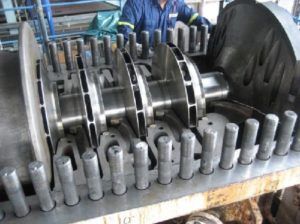Weighing the options to increase centrifugal compressor efficiency
Centrifugal compressors offer some great unique opportunity for energy saving. Some of the typical saving opportunities lie in: 1) Anti-fouling coating resulting in improved performance over longer period of time. 2) Using non-metallic labyrinth seals which can produce lower clearance and also deform slightly. 3) Changing of seals to dry gas seals from wet seals. 4) Performance enhancement using water or liquid washing systems.
There could be much more potential upgrades in impeller flow passage improvements etc. from anti-fouling coating but these are normally expensive upgrades and may not achieve substantial gains to justify them in most cases.
This article contains excerpts from a paper, "Carbon footprint reduction techniques with rotating machinery" by Vasanth M Bhat and Quek Ser King Aaron of Singapore Refining Company presented at the 2016 Asia Turbomachinery & Pump Symposium.

Compressor with non-metallic seals at impeller mouth[/caption]
In a case study it was initially assumed there would be no change required to the rotor or other parts but on assembly it was observed that the labyrinth seals rubbed against the rotor when the horizontal split casing was tightened. It was realized the coating thickness ate up the clearance resulting in jamming of the compressor rotor.
The fouling in the compressor rotor reduced but the foulant continued to foul the flow passages of the stationary diaphragms. We are considering providing a coating to the stationary parts as well so that the performance of the machine could be maintained.
Change to non-metallic labyrinth seal dry gas seals: In a case study, the annual operation costs for seal oil system just based on energy costs was in the tune of US$150,000 per annum in this case. It could be higher or lower depending on the size of the prime mover for the seal oil systems. A typical loss in wet contact seals compared to dry gas seals was in the range of 10 to 15 KW per casing, again a small number but when seen as a total system can prove to be significant.
As with any typical retrofit project keep some contingency in terms of schedule and costs to take care of surprise findings.
Keep an option for full reversal as in some rare cases Dry Gas Seals may not end up as reliable solution.
Depending on familiarity of the site personnel to dry gas systems there should be a robust training program to ensure operators understand the dry gas seal panel which is more complicated in terms of looks compared to seal oil systems.
Online washing systems: Running a fouled compressor always results in higher specific power consumption. Online wash offers a quick remedy to performance degradation but has its own challenges. Water or naphtha has been used to wash but the effectiveness of the wash would depend on the location of the nozzles with respect to the fouling. With washing there are 2 major risks, namely machine could end up going to high vibration if the distribution of the fouling and the cleaning effectiveness varies with location on the rotor, secondly with dry gas seals it gets further complicated with possible risk of contamination reaching the dry gas seals and potentially resulting in its failure.
Due to these risks industry has used it more effectively for gas turbines, main air blower and to much lesser extent in wet gas compressor and recycle gas compressors. Washing of steam turbine rotors has also been done but maintaining a good steam quality would be the area of focus rather than depending on water washing as a solution.